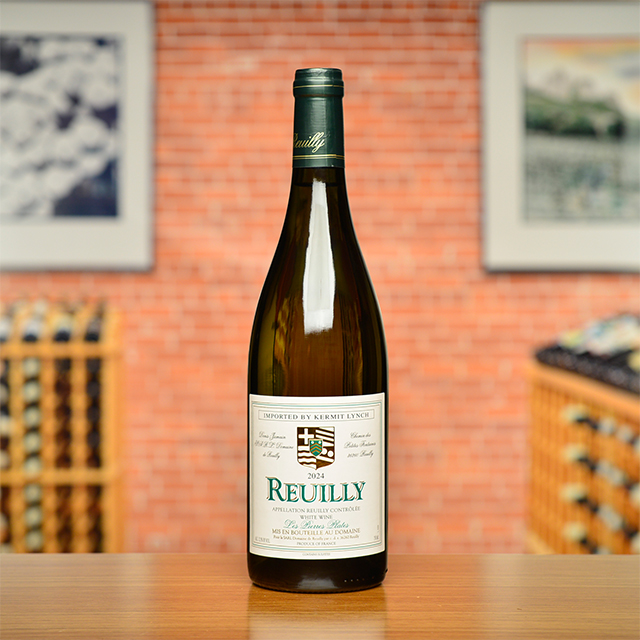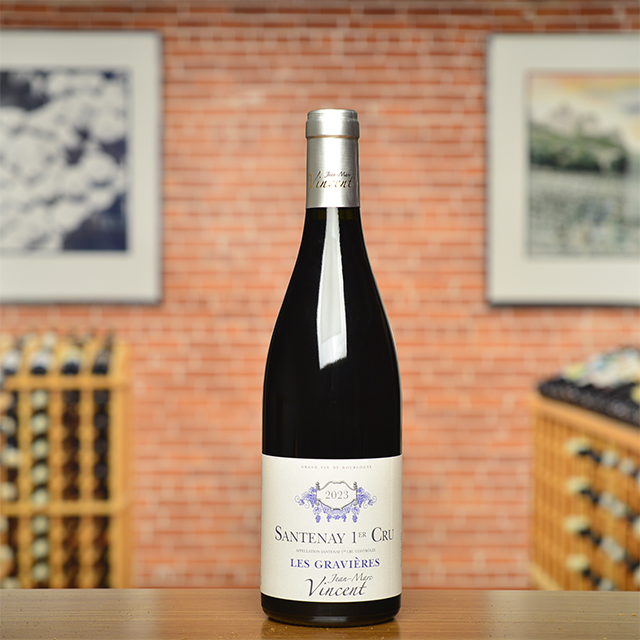Notify me
2019 Reuilly “Les Pierres Plates”
Domaine de Reuilly
Domaine de Reuilly vineyards

Once known as “poor man’s Sancerre,” the wines of Reuilly deserve a new moniker. “Bargain Sancerre” would be more appropriate, or we could just stop comparing the poor thing to Sancerre in the first place. Denis Jamain’s Pierres Plates is from his best Sauvignon Blanc vineyard, named after all the “flat” fossil-encrusted limestone rocks in its soil—soil he has worked organically for many years.
This bottling is consistently one of the Loire’s finest Sauvignon Blancs, showing delicate lime and floral suggestions that sleekly envelop a chalky core. Enjoy it with oysters, with fresh goat cheese, or simply because it provides delightful refreshment at great value.
—Anthony Lynch
| Wine Type: | white |
| Vintage: | 2019 |
| Bottle Size: | 750mL |
| Blend: | Sauvignon Blanc |
| Appellation: | Reuilly |
| Country: | France |
| Region: | Loire |
| Producer: | Domaine de Reuilly |
| Winemaker: | Denis Jamain |
| Vineyard: | 23 years average, 11 ha |
| Soil: | Clay, Kimmeridgian Limestone |
| Farming: | Biodynamic (certified) |
| Alcohol: | 12.5% |
More from this Producer or Region

2021 Bourgueil “La Dilettante”
France | Loire
A delicate, aromatic red in the “drink now!” vein.

2017 Jasnières “Chant de Vigne”
France | Loire
A single-vineyard bottling whose age lends a soft, drawn butter richness to its bright, tart citrus palate.

2018 Muscadet Sèvre et Maine “Gorges”
France | Loire
Gorges boasts an incredible texture and tension imparted by decomposed, blue-green igneous rock, seventy-year-old vines, and years-long aging on the lees.

2024 Reuilly “Les Pierres Plates”
France | Loire
Grassy and piquant with a citrus and mineral-tinged finish, it checks all the boxes.

2021 Chinon “Clos de la Dioterie”
France | Loire
Age-worthy red from one of Chinon’s top sites, by a storied domaine.

2021 Saumur-Champigny “Les Mémoires”
France | Loire
Sourced from 110+ year-old vines, this is hands-down one of the best Cab Francs being made in the Loire Valley today.

2024 Val de Loire Sauvignon Blanc “Unique”
France | Loire
Lime blossoms delivered via a lightning bolt of minerally refreshment.

2020 Saumur Blanc “Clos Romans”
France | Loire
Thierry’s Saumur Blancs are bone-dry, high-acid, mineral Chenin Blancs that drink like Chablis young and take on weight slowly over time.

2019 Vin de France Rouge Grolleau/Cabernet Franc “Clandestine”
France | Loire
A lovely combination of Grolleau Noir and Cabernet Franc, there seems to be a synergistic effect elevating both grapes to create a juicy, spicy, refreshing whole.

2024 Reuilly Pinot Gris Rosé
France | Loire
Citrusy aromatics, bracing salinity, and a mineral backbone make it a mouthwatering match for tangy, herb-laden soups like tom kha gai.
 /
/
About The Producer
Domaine de Reuilly
About The Region
Loire

The defining feature of the Loire Valley, not surprisingly, is the Loire River. As the longest river in France, spanning more than 600 miles, this river connects seemingly disparate wine regions. Why else would Sancerre, with its Kimmeridgian limestone terroir be connected to Muscadet, an appellation that is 250 miles away?
Secondary in relevance to the historical, climatic, environmental, and cultural importance of the river are the wines and châteaux of the Jardin de la France. The kings and nobility of France built many hundreds of châteaux in the Loire but wine preceded the arrival of the noblesse and has since out-lived them as well.
Diversity abounds in the Loire. The aforementioned Kimmeridgian limestone of Sancerre is also found in Chablis. Chinon, Bourgueil, and Saumur boast the presence of tuffeau, a type of limestone unique to the Loire that has a yellowish tinge and a chalky texture. Savennières has schist, while Muscadet has volcanic, granite, and serpentinite based soils. In addition to geologic diversity, many, grape varieties are grown there too: Cabernet Franc, Chenin Blanc, Sauvignon Blanc, and Melon de Bourgogne are most prevalent, but (to name a few) Pinot Gris, Grolleau, Pinot Noir, Pineau d’Aunis, and Folle Blanche are also planted. These myriad of viticultural influences leads to the high quality production of every type of wine: red, white, rosé, sparkling, and dessert.
Like the Rhône and Provence, some of Kermit’s first imports came from the Loire, most notably the wines of Charles Joguet and Château d’Epiré—two producers who are featured in Kermit’s book Adventures on the Wine Route and with whom we still work today.
More from Loire or France
2024 Chinon “Les Granges”
Bernard Baudry France | Loire
2024 Val de Loire Sauvignon Blanc “Unique”
Domaine du Salvard France | Loire
2020 Saumur Champigny “Clos de l’Échelier”
Thierry Germain France | Loire
2020 Chinon “Les Varennes du Grand Clos”
Charles Joguet France | Loire
2024 Cheverny
Domaine du Salvard France | Loire
2021 Saumur Champigny “La Marginale”
Thierry Germain France | Loire
2022 Savennières Roche aux Moines “Clos de Rochepin”
Château d’Epiré France | Loire
2021 Chinon “Le Clos Guillot”
Bernard Baudry France | Loire
2021 Chinon “Les Varennes du Grand Clos”
Charles Joguet France | Loire
2024 Vouvray
Champalou France | Loire
2022 Chinon “Cuvée Terroir”
Charles Joguet France | Loire
2024 Bourgueil “Trinch!”
Catherine & Pierre Breton France | Loire
2024 Chinon “Les Granges”
Bernard Baudry France | Loire
2024 Val de Loire Sauvignon Blanc “Unique”
Domaine du Salvard France | Loire
2020 Saumur Champigny “Clos de l’Échelier”
Thierry Germain France | Loire
2020 Chinon “Les Varennes du Grand Clos”
Charles Joguet France | Loire
2024 Cheverny
Domaine du Salvard France | Loire
2021 Saumur Champigny “La Marginale”
Thierry Germain France | Loire
2022 Savennières Roche aux Moines “Clos de Rochepin”
Château d’Epiré France | Loire
2021 Chinon “Le Clos Guillot”
Bernard Baudry France | Loire
2021 Chinon “Les Varennes du Grand Clos”
Charles Joguet France | Loire
2024 Vouvray
Champalou France | Loire
2022 Chinon “Cuvée Terroir”
Charles Joguet France | Loire
2024 Bourgueil “Trinch!”
Catherine & Pierre Breton France | Loire
Kermit once said...

Kermit once said...
I want you to realize once and for all: Even the winemaker does not know what aging is going to do to a new vintage; Robert Parker does not know; I do not know. We all make educated (hopefully) guesses about what the future will bring, but guesses they are. And one of the pleasures of a wine cellar is the opportunity it provides for you to witness the evolution of your various selections. Living wines have ups and downs just as people do, periods of glory and dog days, too. If wine did not remind me of real life, I would not care about it so much.
Inspiring Thirst, page 171














